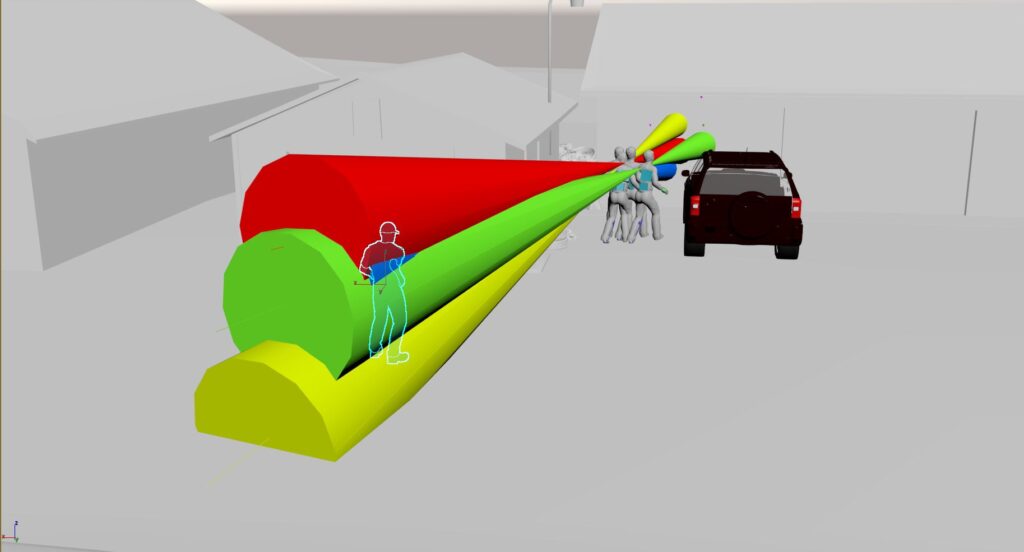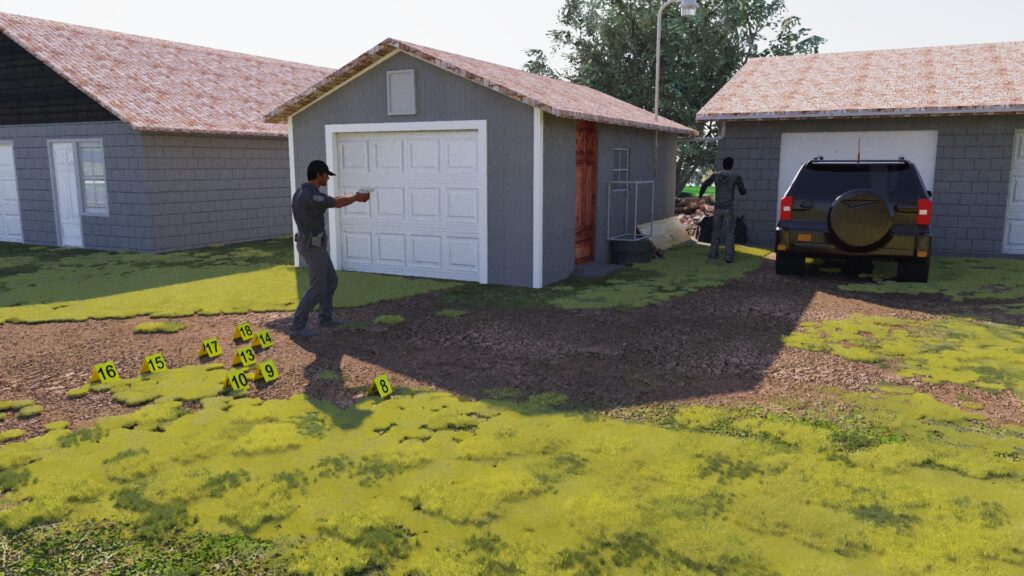Trajectory analysis is a key element to accurately reconstructing a shooting event. Most often, police investigators or forensic experts perform this analysis by reverse-engineering an incident from the resting points of bullets fired. The results of this analysis often bear high stakes in a criminal case; enough so an inaccurate analysis could imprison an innocent person or liberate a person guilty of unjust malice. These stakes demand that investigators use the most accurate and appropriate methodologies.
Until the 2000s, the standard practice for forensic trajectory analysis consisted of inserting long, skinny trajectory rods into evidence of a bullet’s path of travel, then observing where the length of the rod traced back. This tracing would allow experts to observe the angle(s) of one or more bullets fired in an incident and determine an origin point.
This method sufficed for an expert’s basic in-person observation but was clumsy and prone to human error. To record results, experts could only record angles with protractors and distances with measuring tapes, then either note or photograph the results for data collection. Meanwhile, the rods themselves could lean under their own weight and provide inaccurate tracing results, leading to inaccurate conclusions on the truth of an incident. Primary issues were the efficiency and reliability of recording these three-dimensional measurements.
Introduction of lidar measurement
The advent of 3D laser scanning, i.e. lidar, provided a direct solution to the inefficiency and inaccuracy of previous methodologies. By scanning a trajectory rod inserted into ballistic evidence, experts could capture the exact 3D measurements of the rod’s place in space, angle of entry, and the exact shape of the entry damage down to millimeter scale. Lidar scanning also enabled experts to capture measurement data for the entire environment of a shooting, allowing consideration of contextual influences.
Because this process is dependably precise, requires minimal effort, and can be completed within a matter of minutes, lidar measurement became a natural match for ballistic trajectory analysis. It also empowers investigators to rely more on ballistic trajectory analysis in view of the precision and reliability of analyses based on lidar measurement.
By placing lidar measurements in 3D modelling software, experts can certify the accuracy of this scan data. Experts should look at the trajectory angle scan closest to the bullet’s entry and model an extension of that angle as far back as possible with a straight line. This ensures that the straight path of the trajectory is verified, independent of whether the rest of the rod had leaned or been held wrong. This process provides precise, dependable trajectory tracing that could never have been verified through past methodologies.
Greater capability for analysis
One of the most important considerations for ballistic trajectory analysts is considering the five-degree window of error. This rule outlines that because factors like impact misdirection or friction affect how a bullet travels through an obstruction, a window of error of five degrees must be accounted for when tracing a bullet from an entry angle to origin. Thus bullets fired at close range will not have a large variable distance, but the origin of bullets fired from greater distance could vary substantially.
This condition would make it nearly impossible to calculate a five-degree window in the traditional method of trajectory analysis. No elegant tool or method existed that would allow experts to extend an expanding five-degree cone from a bullet entry to the average distance of a shooting before lidar measurement. This means experts practicing the traditional method of trajectory analysis would have to make assumptions on trajectory origins or state outright that the true three-dimensional origin of a fired bullet can’t be asserted.
However, by inputting lidar scanned trajectory measurements into modelling software, five-degree cones can be added to verify a trajectory’s origin as far back as needed. With modifiable tracing cones, experts can assert the potential origin of a fired bullet with much greater certainty than ever before.
Another key analysis made possible through the input of lidar scanned trajectory measurements in modelling software is the ability to determine with greater certainty a shooter’s position when multiple rounds were fired in a tight area. This analysis is built upon the previously mentioned 3D modelled five-degree error analysis and allows experts to further certify a shooter’s location.
When experts trace five-degree windows of error for multiple shots fired in a tight pattern, the five-degree cones will grow and intersect at a certain distance. Like a Venn diagram, experts can find the intersecting section between all bullets’ five-degree error windows and know the gun that fired these shots had to be in this area.

Five-degree ballistic cones modeled over scan data provide comprehensive ballistic trajectory visualizations.
Finally, it can be useful for experts that once completed, these 3D modelled trajectory analyses can functionally serve as visual exhibits supporting the claims of a forensic trajectory analysis. The ability to communicate proof for a conclusion is crucial to convincing an audience, and by the time trajectory Lidar measurements have been modelled into a five-degree error analysis, it can serve as a demonstrative exhibit itself.
Today, the practice of lidar trajectory scanning has been adopted by investigative bodies around the world including the FBI and a growing number of American police departments. The relationship between lidar measurement and trajectory analysis was a natural match, and a necessary advancement for criminal investigation. This process will likely serve as the primary format for trajectory analysis for many years. Because of the previously mentioned benefits, we continue to advocate for the adoption of this practice among all investigators devoted to providing top-level analysis.

